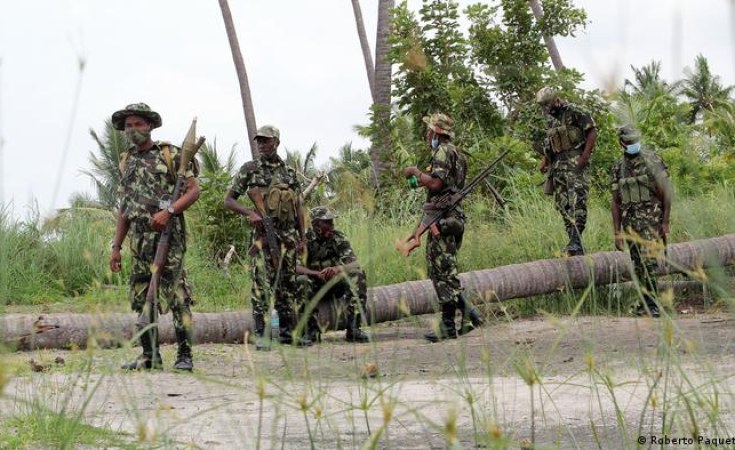The heaviest fighting continues in two places that will worry TotalEnergies. The map below shows insurgents have not been pushed far out of the two gas districts of Palma and Mocimboa da Praia, which TotalEnergies will want as its security zone.
In Nangade district on the Rovuma River border with Tanzania, battles have effectively closed the road from Mueda to Palma.
And in northwest Macomia district there is an insurgent presence along the heavily forested Messalo river and in mountainous areas to the south. "During the Mozambican War of Independence, this area was considered largely impenetrable by the Portuguese military,"notes Cabo Ligado (29 Nov). This fighting disrupts the N380, the only paved road that links Pemba with the gas zone; several vehicles were ambushed on 20 November killing five people, including the Palma police chief of operations Manuel Truca, and a Mozambican worker for the French NGO Solidarites International.
Rwandan troops are keeping open the road from Mocimboa da Praia west to Mueda, which runs through a gap between two zones of fighting.
The map above from Cabo Ligado (29 Nov) shows attacks and fighting in the past three months, with November the darkest colour. The map also shows the increasing presence of insurgents in the west and south - Montepuez, Balama, Namuno and Chiure districts - which had been less affected by the war.
For example, in a demonstration of strength on 30 November, in Maravi, Namuno, a young man on his farm was captured by insurgents who took him to the nearby woods, showing him many more armed insurgents. Before beating the victim, the insurgents gave the man the following message: “Go to your village and say that we are here”.
In Mocimboa da Praia district an estimated 72,000 displaced people have returned, the port reopened on 29 November, and there has been a partial return to normality. But the map shows a continued insurgent presence in the south of the district. In Mbau on 16 November at least two fishermen were beheaded. On 24 November 20 men, half armed with guns and the others with machetes, surrounded a vehicle and shot the driver dead before moving into the village of Calugo on the R762 road south of Mocimboa da Praia town.
No one else was killed or injured, but they stole food from the market and asked the residents, “Who told you to return to Mocimboa?”
In Nangade, 300 Tanzanian troops arrived in October as part of the SADC mission in Mozambique (SAMIM) and have been involved in heavy fighting. On 15 November, insurgents ambushed a Tanzanian convoy near Mungano village, wounding three soldiers and damaging three vehicles with rocket-propelled grenades (RPGs). Three insurgents were also killed during the altercation but the Tanzanians were not able to repel the insurgents and were forced to retreat, allowing the insurgents to seize weaponry and equipment. SAMIM announced that on 29 November in a battle in Nkonga village, they attacked a base and killed 30 insurgents and lost two, one soldier from Tanzania and one from Botswana.
On 22 November, the Naparama militia pursued 20 insurgents to Nairoto in Montepuez district, on the bank of the Messalo river. Equipped only with bows and arrows, the Naparamas clashed with the insurgent fighters while chanting hymns. Five of the Naparamas were captured and beheaded.
Two much-travelled second hand aircraft were delivered to the Mozambican Air Force on 14 November by the South African firm, Paramount Group, which has links with Dyke Advisory Group which earlier was providing air support for the for the Ministry of Interior in Cabo Delgado. The planes are a Czech LET L-410 and a Spanish CASA CN235, with 17 and 30 seats, respectively, for military operations and cargo transport, according to the commander of the Mozambican Air Force, Cândido Tirando. He said they have the ability to land on "unconventional runways and unprepared land," and both were "equipped to allow for greater deployment capability of special forces," including paratroopers. Paramount and its Dubai-based partner Burnham Global have supplied armoured vehicles, helicopters and training. The CN235 was built in 1987, flown by the Botswana air force until 2011, then passed through the hands of Togo, South Africa and Madagascar.
(Sources: Cabo Ligado, Pinnacle News, Zitamar, Focus Group, Carta de Moçambique, Noticias)


